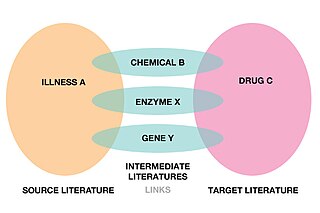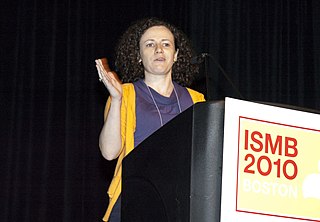
Bioinformatics is an interdisciplinary field of science that develops methods and software tools for understanding biological data, especially when the data sets are large and complex. Bioinformatics uses biology, chemistry, physics, computer science, computer programming, information engineering, mathematics and statistics to analyze and interpret biological data. The subsequent process of analyzing and interpreting data is referred to as computational biology.
Biomedical text mining refers to the methods and study of how text mining may be applied to texts and literature of the biomedical domain. As a field of research, biomedical text mining incorporates ideas from natural language processing, bioinformatics, medical informatics and computational linguistics. The strategies in this field have been applied to the biomedical literature available through services such as PubMed.
Multifactor dimensionality reduction (MDR) is a statistical approach, also used in machine learning automatic approaches, for detecting and characterizing combinations of attributes or independent variables that interact to influence a dependent or class variable. MDR was designed specifically to identify nonadditive interactions among discrete variables that influence a binary outcome and is considered a nonparametric and model-free alternative to traditional statistical methods such as logistic regression.

David Haussler is an American bioinformatician known for his work leading the team that assembled the first human genome sequence in the race to complete the Human Genome Project and subsequently for comparative genome analysis that deepens understanding the molecular function and evolution of the genome.

Søren Brunak is a Danish biological and physical scientist working in bioinformatics, systems biology, and medical informatics. He is a professor of Disease Systems Biology at the University of Copenhagen and professor of bioinformatics at the Technical University of Denmark. As Research Director at the Novo Nordisk Foundation Center for Protein Research at the University of Copenhagen Medical School, he leads a research effort where molecular-level systems biology data are combined with phenotypic data from the healthcare sector, such as electronic patient records, registry information, and biobank questionnaires. A major aim is to understand the network biology basis for time-ordered comorbidities and discriminate between treatment-related disease correlations and other comorbidities in disease trajectories. Søren Brunak also holds a position as a Medical Informatics Officer at Rigshospitalet, the Capital Region of Denmark.
Bioimage informatics is a subfield of bioinformatics and computational biology. It focuses on the use of computational techniques to analyze bioimages, especially cellular and molecular images, at large scale and high throughput. The goal is to obtain useful knowledge out of complicated and heterogeneous image and related metadata.

Philip Eric Bourne is an Australian bioinformatician, non-fiction writer, and businessman. He is currently Stephenson Chair of Data Science and Director of the School of Data Science and Professor of Biomedical Engineering and was the first associate director for Data Science at the National Institutes of Health, where his projects include managing the Big Data to Knowledge initiative, and formerly Associate Vice Chancellor at UCSD. He has contributed to textbooks and is a strong supporter of open-access literature and software. His diverse interests have spanned structural biology, medical informatics, information technology, structural bioinformatics, scholarly communication and pharmaceutical sciences. His papers are highly cited, and he has an h-index above 80.

Literature-based discovery (LBD), also called literature-related discovery (LRD) is a form of knowledge extraction and automated hypothesis generation that uses papers and other academic publications to find new relationships between existing knowledge. Literature-based discovery aims to discover new knowledge by connecting information which have been explicitly stated in literature to deduce connections which have not been explicitly stated.

Olga G. Troyanskaya is an American scientist. She is Professor in the Department of Computer Science and the Lewis-Sigler Institute for Integrative Genomics at Princeton University and the Deputy Director for Genomics at the Flatiron Institute's Center for Computational Biology in New York City. She studies protein function and interactions in biological pathways by analyzing genomic data using computational tools.

Robert F. Murphy is Ray and Stephanie Lane Professor of Computational Biology Emeritus and Director of the M.S. Program in Automated Science at Carnegie Mellon University. Prior to his retirement in May 2021, he was the Ray and Stephanie Lane Professor of Computational Biology as well as Professor of Biological Sciences, Biomedical Engineering, and Machine Learning. He was founding Director of the Center for Bioimage Informatics at Carnegie Mellon and founded the Joint CMU-Pitt Ph.D. Program in Computational Biology. He also founded the Computational Biology Department at Carnegie Mellon University and served as its head from 2009 to 2020.
Translational bioinformatics (TBI) is a field that emerged in the 2010s to study health informatics, focused on the convergence of molecular bioinformatics, biostatistics, statistical genetics and clinical informatics. Its focus is on applying informatics methodology to the increasing amount of biomedical and genomic data to formulate knowledge and medical tools, which can be utilized by scientists, clinicians, and patients. Furthermore, it involves applying biomedical research to improve human health through the use of computer-based information system. TBI employs data mining and analyzing biomedical informatics in order to generate clinical knowledge for application. Clinical knowledge includes finding similarities in patient populations, interpreting biological information to suggest therapy treatments and predict health outcomes.

Christopher G. Chute is a Bloomberg Distinguished Professor at Johns Hopkins University, physician-scientist and biomedical informatician known for biomedical terminologies and health information technology (IT) standards. He chairs the World Health Organization Revision Steering Group for the revision of the International Classification of Diseases (ICD-11).
Relief is an algorithm developed by Kira and Rendell in 1992 that takes a filter-method approach to feature selection that is notably sensitive to feature interactions. It was originally designed for application to binary classification problems with discrete or numerical features. Relief calculates a feature score for each feature which can then be applied to rank and select top scoring features for feature selection. Alternatively, these scores may be applied as feature weights to guide downstream modeling. Relief feature scoring is based on the identification of feature value differences between nearest neighbor instance pairs. If a feature value difference is observed in a neighboring instance pair with the same class, the feature score decreases. Alternatively, if a feature value difference is observed in a neighboring instance pair with different class values, the feature score increases. The original Relief algorithm has since inspired a family of Relief-based feature selection algorithms (RBAs), including the ReliefF algorithm. Beyond the original Relief algorithm, RBAs have been adapted to (1) perform more reliably in noisy problems, (2) generalize to multi-class problems (3) generalize to numerical outcome problems, and (4) to make them robust to incomplete data.
Marylyn D. Ritchie is a Professor of Genetics, the Director of the Center for Translational Bioinformatics, the Associate Director for Bioinformatics in the Institute for Biomedical Informatics, and the Associate Director of the Center for Precision Medicine, at the University of Pennsylvania's Perelman School of Medicine.

Ümit V. Çatalyürek is a professor of computer science at the Georgia Institute of Technology, and adjunct professor in department of Biomedical Informatics at the Ohio State University. He is known for his work on graph analytics, parallel algorithms for scientific applications, data-intensive computing, and large scale genomic and biomedical applications. He was the director of the High Performance Computing Lab at the Ohio State University. He was named Fellow of the Institute of Electrical and Electronics Engineers (IEEE) in 2016 for contributions to combinatorial scientific computing and parallel computing.
Michel Justin Dumontier is a Distinguished Professor of Data Science at Maastricht University. His research focuses on methods to represent knowledge on the web with applications for drug discovery and personalized medicine. He was previously an Associate Professor of Medicine at the Stanford University School of Medicine and an Associate Professor of Bioinformatics at Carleton University. He is best known for his work in biomedical ontologies, linked data and biomedical knowledge discovery. He has taught courses on biochemistry, bioinformatics, computational systems biology, and translational medicine. His research has been funded by Natural Sciences and Engineering Research Council, Canada Foundation for Innovation, Mitacs Canada, the Ontario Ministry of Research, Innovation and Science, CANARIE, and the US National Institutes of Health. Dumontier has an h-index of over 30 and has authored over 125 scientific publications in journals and conferences. He lives in Maastricht with his wife Tifany Irene Leung and their lionhead rabbit Storm.
Automated machine learning (AutoML) is the process of automating the tasks of applying machine learning to real-world problems. It is the combination of automation and ML.
Debasis Dash is an Indian computational biologist and chief scientist at the Institute of Genomics and Integrative Biology (IGIB). Known for his research on proteomics and Big Data and Artificial Intelligence studies, his studies have been documented by way of a number of articles and ResearchGate, an online repository of scientific articles has listed 120 of them. The Department of Biotechnology of the Government of India awarded him the National Bioscience Award for Career Development, one of the highest Indian science awards, for his contributions to biosciences, in 2014. He was appointed as the director of Institute of Life Sciences, Bhubaneswar on 18 May 2023.
Keith A. Crandall is an American computational biologist, bioinformaticist, and population geneticist at George Washington University, where he is the founding director of the Computational Biology Institute, and professor in the Department of Biostatistics and Bioinformatics.
Biomedical data science is a multidisciplinary field which leverages large volumes of data to promote biomedical innovation and discovery. Biomedical data science draws from various fields including Biostatistics, Biomedical informatics, and machine learning, with the goal of understanding biological and medical data. It can be viewed as the study and application of data science to solve biomedical problems. Modern biomedical datasets often have specific features which make their analyses difficult, including:









